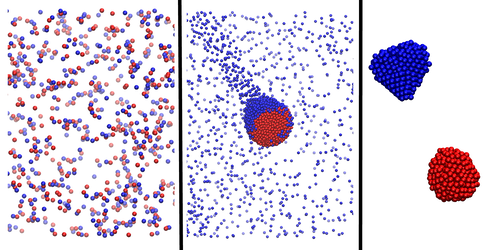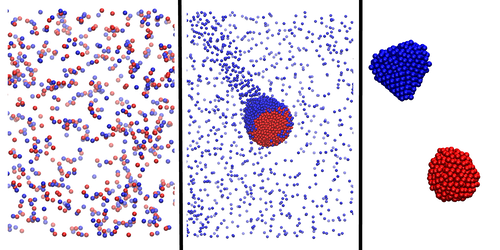Chemical Conversations Lead to Particle Cliques
Some bacterial cells secrete chemicals that influence both their motion and that of neighboring cells. Similarly, inside a cell, an enzyme can catalyze a reaction and “emit” products, which can influence neighboring molecules. New simulations reveal the variety of structures that can form—such as autonomously swimming clusters—as cells or molecules that influence each other move around and reorganize.
Peculiar behaviors can arise when particles that produce or consume chemicals interact with one another. For example, one particle might back away from a second particle, while the second particle tries to cozy up to the first, leading to a chase. This asymmetry in particle interactions appears to break Newton’s third law of motion, which states that every action has an equal and opposite reaction. Jaime Agudo-Canalejo of the University of Oxford and Ramin Golestanian at the Max Plank Institute for Dynamics and Self-Organization in Germany set out to study these behaviors by simulating how mixtures of such chemically interacting particles move about. Depending on the ratio of producers to consumers as well as each particle’s characteristics—such as how much of a chemical they make or use—the researchers observed a dizzying array of phenomena.
In some cases, the particles bonded in molecule-like chains (see video). In others, the producers and consumers separated into tight-knit cliques (see video). Occasionally a mob of consumers chased a horde of producers across the virtual landscape (see video). In another example, corresponding to the parameters expected for enzymes, the duo observed the formation of “optimal” clusters in which the products of one particle were passed on to the next with zero waste.
The researchers say that all these clustering and chasing behaviors are part of a new class of so-called active phase separation, which arises from particles responding to changing chemical imbalances rather than to some time-invariant self-propulsion mechanism, as is more commonly studied.
This research is published in Physical Review Letters.
–Christopher Crockett
Christopher Crockett is a freelance writer based in Arlington, Virginia.





